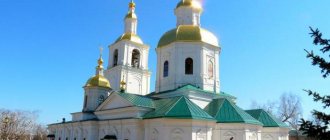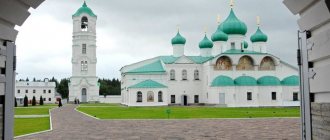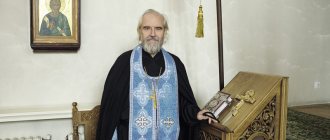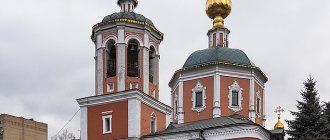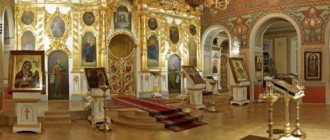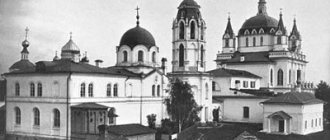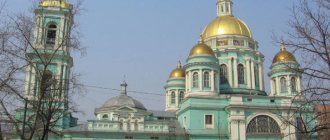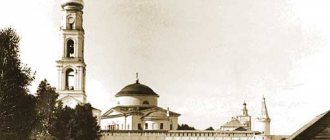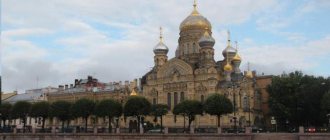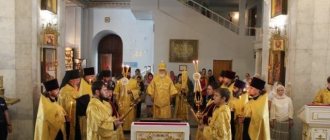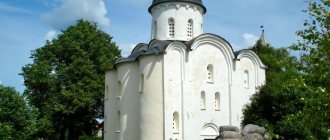| Folk heroes approve of this article. Therefore, they recommend continuing the text in the same spirit |
Official website of the Nizhny Novgorod Diocese
Nizhny Novgorod (and Arzamas) Diocese
— church and administrative structure of the Russian Orthodox Church of the Moscow Patriarchate in the Nizhny Novgorod region. The rector is Metropolitan Georgy (Danilov) of Nizhny Novgorod and Arzamas.
The cathedral city (the seat of the bishop) is Nizhny Novgorod.
Cathedrals: from September 12, 2009 - Alexander Nevsky in Nizhny Novgorod and the Resurrection of the Word in Arzamas.
Until September 2009, the cathedral in Nizhny Novgorod was the Spaso-Preobrazhensky (Old Fair) Cathedral, until 1930 - the Spaso-Preobrazhensky Cathedral in the Nizhny Novgorod Kremlin.
Story
Before the creation of the Nizhny Novgorod Metropolis in 2012, the Arzamas Deanery
included churches in the Arzamas and Vad districts of the Nizhny Novgorod region[1] and was part of the central district of the Nizhny Novgorod and Arzamas diocese.
When the metropolis was created, the churches of the Vad district were first included in the Sergach deanery of the newly created Lyskovsky diocese, and then from the Sergach district they were allocated to the Perevoz deanery.
In 2013, the deanery began publishing the newspaper “Orthodox Arzamas.”[2] In the same year, the 32nd parish was opened.[3]
Then Arzamas deanery
was divided into two:
the Deanery of the city of Arzamas
and
the Deanery of the Arzamas region
.
History[edit]
The early years of the metropolitan see in Nizhny Novgorod[edit]
The decision to create a separate Nizhny Novgorod diocese was made back in 1589 at the XXVIII Moscow Council. This decision was accelerated by the dangerous multiplication of supporters of the Old Believers in the “Nizovskaya land”, where Moscow Old Believers, as well as Razinites - participants in the Peasant War (1670-1671), found refuge in large numbers.
On March 24 (April 3), 1672, the Nizhny Novgorod diocese was established. To manage the newly discovered diocese, an experienced and trustworthy husband was needed. The choice fell on Archimandrite Philaret of the Pechersk Ascension Monastery. He served as Metropolitan of Nizhny Novgorod and Alatyr for more than 9 years, from July 2, 1672 to March 7, 1682.
From its establishment in 1672 until the end of the 18th century, the residence of the bishops was in the Nizhny Novgorod Kremlin; under Bishop Damascus, the residence was moved to a new building built on the territory of the abolished Ivanovo Monastery.
Gorky diocese[edit]
See also: History of the Russian Church after 1941
Before the start of the Great Patriotic War, the Gorky diocese was close to destruction: almost all churches were closed or no longer existed; all churches in Gorky were closed.
According to calculations in 1943, of the 1,126 church buildings in the diocese, 892 were used for clubs, schools and warehouses, and 228 were destroyed, empty. In 1945, 13 churches were opened, 1946 - 6, 1947 - 3, 1948 - 2 churches.
In 1950, there were 47 registered churches in the diocese, including 3 in Gorky. In addition, there were about 60 unregistered houses of worship, in which services were performed by unemployed priests and laymen. In particular, in Vorsma, the prayer house of Nikolai Bratanov was designed for 20-25 people, while according to the data of the person authorized for the Easter service, there were 200-250 people praying on the street near the house. In 1950-1956, the number of parishes in the diocese did not change, while at the same time the number of parishes throughout the country decreased noticeably. In 1956, the Kazan Church was opened in Vorsma.
In modern Russia[edit]
In 1996, the website of the diocese was opened, which became the first Orthodox website in Russia. In 2003, a modern version of the site appeared. In October 2008, an English version appeared, reproducing the daily news feed of the Russian Orthodox Church and the Nizhny Novgorod diocese. By 2010, the site was visited monthly by about 30 thousand people. On July 16, 2005, the Orthodox helpline began operating. Over the five years of operation, it received 63 thousand calls.
By the beginning of 2007, there were 414 operating churches in the diocese.
In 2009, the Feodorovsky Monastery was restored in the diocese, 8 new parishes were opened, 9 churches and 3 chapels were consecrated. On September 9 - September 12, 2009, Patriarch Kirill visited Nizhny Novgorod, during which the Cathedral in honor of the Holy Prince Alexander Nevsky in Nizhny Novgorod was given cathedral status.
In December 2009, a delegation of 118 people led by Archbishop Georgy of Nizhny Novgorod and Arzamas and Bishop Veniamin of Lyubertsy made a five-day pilgrimage to the shrines of Sinai, Cairo and Alexandria.[20] At the Monastery of St. Catherine, an exception was made for Nizhny Novgorod pilgrims - they were allowed to hold a service.
Bishops[edit]
For 330 years, the Nizhny Novgorod department was ruled by 48 bishops.
1937-1941 - the department became a widow.
- Filaret (2 June 1672 - 7 March 1686)
- Paul (March 7, 1686 - September 26, 1696)
- Trifilius (Inikhov) (1696 - July 20, 1699)
- Isaiah (July 23, 1699 – June 1708)
- Sylvester (Volynsky) (September 14, 1708 - March 5, 1719)
- Pitirim (23 March 1719 - 8 May 1738)
- John (Dubinsky) (February 25, 1739 - September 1, 1742)
- Dimitri (Sechenov) (September 12, 1742 - August 9, 1748)
- Veniamin (Putsek-Grigorovich) (August 14, 1748 - February 28, 1753)
- Feofan (Charnutsky) (March 14, 1753 - June 1, 1773)
- Anthony (Gerasimov-Zybelin) (July 9, 1773 - April 25, 1782)
- Joasaph (Zabolotsky) (May 16, 1782 - September 22, 1783)
- Damascene (Rudnev) (September 22, 1783 - January 12, 1794)
- Pavel (Ponomarev) (February 12, 1794 - October 26, 1798)
- Veniamin (Krasnopevkov) (October 26, 1798 - March 16, 1811)
- Moses (Gemini-Platonov) (May 28, 1811 - January 10, 1825)
- Samuil (Zapolsky-Platonov) (1825-1826) v/u
- Methodius (Sokolov) (February 28 - October 19, 1826)
- Afanasy (Protopopov) (October 13, 1826 - January 24, 1832)
- Ambrose (Morev) (February 1, 1832 - January 19, 1835)
- John (Dobrozrakov) (January 19, 1835 - January 13, 1847)
- Jacob (Vecherkov) from 1847 to 1850.
- Jeremiah (Soloviev) from 1851 to June 11, 1857.)
- Anthony (Pavlinsky) (July 20, 1857 - September 29, 1860
- Nektary (Nadezhdin) (September 22, 1860 - January 21, 1869)
- Filaret (Malyshevsky) (February 28, 1869 - February 7, 1873)
- Ioannikiy (Rudnev) (June 13, 1873 - December 8, 1877)
- Chrysanthus (Retivtsev) (December 8, 1877 - May 23, 1879)
- Bishop of Nizhny Novgorod and Arzamas Makariy (Mirolyubov) (May 23, 1879 - June 7, 1885)
- Modest (Strelbitsky) (June 7, 1885 - November 25, 1889)
- Vladimir (Petrov) (November 25, 1889 - May 7, 1892)
- Vladimir (Nikolsky) (May 7, 1892 - December 29, 1900)
- Nazariy (Kirillov) (January 20, 1901 - August 13, 1910)
- Joachim (Levitic) from 1910 to 1918.
- Lavrenty (Knyazev), Bishop of Balakhninsky, vicar of the Nizhny Novgorod diocese served from 1917 to 1918.
- Evdokim (Meshchersky) from 1918 to 1924.
- Sergius (Stragorodsky) from March 31, 1924 to April 27, 1934.
- Evgeny (Zernov) (May 1934 - May 1935)
- Feofan (Tulyakov) (November 12, 1935 - October 4, 1937) On September 21, 1937, Metropolitan Feofan was sentenced to death by the Special Troika of the NKVD for the Gorky Region. On October 4 of the same year, the sentence was carried out.
- 1937–1941: no bishops appointed
- Sergius (Grishin) (November/December 1941 - May 20, 1942)
- Andrey (Komarov) (May 28 - July 13, 1942)
- Sergius (Grishin) (July 13, 1942 - October 14, 1943)
- Zinovy (Krasovsky) (1944 - November 18, 1948)
- Korniliy (Popov) (November 18, 1948 - August 14, 1961)
- Metropolitan Nikolai (Kutepov) of Nizhny Novgorod and Arzamas
- John (Alekseev) (August 14, 1961 - May 1965)
- Mstislav (Volonsevich) (May 25, 1965 - January 14, 1966)
- Flavian (Dmitriyuk) (July 7, 1966 - March 3, 1977)
- Nikolay (Kutepov) from June 11, 1977 to June 21, 2001.
- Evgeniy (Zhdan) (temporarily from June 21, 2001) from March 2002 to October 11, 2002.
- Georgy (Danilov) (from December 26, 2002)
Deanery of the city of Arzamas
- Resurrection Cathedral of the Nizhny Novgorod diocese.
- Church of the Holy Spirit
- Church in honor of the Tikhvin Icon of the Mother of God. The temple was consecrated on November 7, 2010 by Archbishop George[4]
- Church in honor of the icon of the Mother of God “The Sign”. The temple was consecrated on November 13, 2010 by Archbishop George[5]
- Church in honor of the Kazan Icon of the Mother of God. The temple was consecrated on January 16, 2011 by Archbishop George[6]
- Church in honor of the Entry of the Lord into Jerusalem. Built in 1777. Closed in 1928. In 2004 it was returned to the Nizhny Novgorod diocese.[7] On March 11, 2012, services resumed[8] On April 8, 2012, the first Divine Liturgy after an 80-year break was celebrated.[9]
No. 45 (654) / November 28 '11
Diocese
Archbishop of Nizhny Novgorod and Arzamas Georgy
Date of birth: August 14, 1964 Date of consecration: February 2, 2003 Date of tonsure: December 22, 1989 Angel Day: May 6
- Born in the city of Zhlobin, Gomel region of Belarus, in a large family. Baptized the same year in the Church of the Life-Giving Trinity in Zhlobin.
- In 1981 he graduated from high school. After graduating from school, he worked as a driver, and from May 1984 to June 1986 he served in the ranks of the Soviet army.
- After being transferred to the reserve in 1986, he entered the Moscow Theological Seminary.
- In November of the same year he was accepted as a novice at the Trinity-Sergius Lavra. He took monastic tonsure with the name George (in honor of the Holy Great Martyr George the Victorious) on December 22, 1989, on the day of the feast of the icon of the Mother of God “Unexpected Joy”.
- In 1990 he graduated from seminary and entered the Moscow Theological Academy.
- October 9, 1990, on the day of the feast of the repose of St. Apostle and Evangelist John the Theologian was ordained as hierodeacon by Bishop Vincent (Morar), vicar of the Chisinau diocese (now Metropolitan of Tashkent and Uzbekistan).
- On April 9, 1991, on the day of the feast of the Iveron Icon of the Mother of God, His Holiness Patriarch Alexy II of Moscow and All Rus' was ordained hieromonk.
- Since November 1991, he served as the head of the candle workshop. On January 20, 1993, he was appointed economist of the Trinity-Sergius Lavra.
- In June 1995 he graduated from the Moscow Theological Academy with a candidate of theology degree in the department of history of the Russian Church (theme of the dissertation is “The Life and Patriarchal Ministry of St. Tikhon (Belavin)”). After graduating from the MDA, he taught general church history and Byzantine studies in the 3rd year of the Moscow Theological Seminary, while continuing to serve as the monastery’s steward. Working as an economist of the Lavra, in August 1998 he was appointed to the position of director of the Patriarchal Architectural and Restoration Center in the Trinity-Sergius Lavra.
- Since 1999, he has carried out extensive work on the restoration of churches and monastery buildings and reconstruction of the monastery territory (in particular, during the work, a large-scale restoration of the Lavra bell tower was undertaken and its largest bells, lost in the 1930s, were recreated).
- On May 31, 2001, by decree of the Holy Archimandrite of the Holy Trinity Sergius Lavra, His Holiness Patriarch of Moscow and All Rus', Alexy II was appointed economist of the United Economy of the Trinity-Sergius Lavra and Moscow Theological Schools.
- On December 26, 2002, at a meeting of the Holy Synod of the Russian Orthodox Church, he was determined to be the Bishop of Nizhny Novgorod and Arzamas.
- On February 1, 2003, in the home church of All Saints, in the Russian Land of the Enlightened Ones, the Patriarchal residence of the St. Daniel Monastery, the rite of naming Archimandrite George (Danilov) Bishop of Nizhny Novgorod and Arzamas was performed by His Holiness Patriarch of Moscow and All Rus' Alexy II, Metropolitans of Krutitsky and Kolomna Juvenaly, Solnechnogorsk Sergius, manager of the affairs of the Moscow Patriarchate, Volokolamsk and Yurievsk Pitirim, Cheboksary and Chuvash Varnava, Chernivtsi and Bukovina Onufriy, archbishops of Vitebsk and Orsha Dimitri, Istra Arseny, Gomel and Zhlobin Aristarkh, Vereisky Evgeniy, bishops of Orekhovo-Zuevsky Alexy, Yaroslavl and Rostov Kirill, Magadan and Sinegorsk Feofan, Dmitrovsky Alexander, Bryansky and Sevsky Theophylact, Tambov and Michurinsky Theodosius.
- On February 2, 2003, in the Cathedral of Christ the Savior, His Holiness Patriarch Alexy II of Moscow and All Rus' led the consecration of Archimandrite George as Bishop of Nizhny Novgorod and Arzamas.
- Considering the importance of the Nizhny Novgorod diocese in the life of the Russian Orthodox Church and in consideration of the diligent service of the Church of God, Bishop Georgy of Nizhny Novgorod and Arzamas was awarded the elevation to the rank of archbishop on February 24, 2006.
Education:
- 1990 – Moscow Theological Seminary;
- 1995 – Moscow Theological Academy; candidate's dissertation on the topic “The Life and Patriarchal Ministry of St. Tikhon (Belavin).”
Place of work:
- Charitable Foundation of St. Seraphim of Sarov (chairman of the board of the foundation).
Awards
- church: – 2009 – Order of St. Seraphim of Sarov, II degree; - Order of St. Innocent, Met. Moscow and Kolomenskoye, II degree; – Order of St. Alexander Nevsky, 1st degree.
- secular: - Order of Friendship.
Brief information
Date of creation: 1672. Address: 603058, Russia, Nizhny Novgorod, st. Suzdalskaya, 58. Telephone: (diocesan secretary); (831) 258-09-19 (office). Fax machine: . Email:
Cathedral city - Nizhny Novgorod, cathedrals: from September 12, 2009 - Alexander Nevsky (Nizhny Novgorod) and Resurrection of the Word (Arzamas). Until September 2009, the cathedral in Nizhny Novgorod was the Spaso-Preobrazhensky (Old Fair) Cathedral, and until 1930 - the Spaso-Preobrazhensky Cathedral in the Kremlin.
Monasteries
men's
- Blagoveshchensky: 603001, Nizhny Novgorod, lane. Melnichny, 1; tel. ; website: blagovm.ru;
- Voznesensky Pechersky: 603063, Nizhny Novgorod, Privolzhskaya Sloboda, 108; tel. (831) 436-25-79, 436-17-15; website: pechory.nne.ru;
- Vysokovsky Koverninsky Uspensky: 606570, Nizhny Novgorod region, Koverninsky district, Vyselki village;
- Oransky Bogoroditsky: 606125, Nizhny Novgorod region, Bogorodsky district, village. Oranki; tel. (83170) 4-55-45; website: oranki.narod.ru;
- Holy Dormition Sarov Hermitage: Nizhny Novgorod region, Sarov; website: sarov-monastery.org;
- Holy Dormition Monastery of Florishcheva Pustyn: Nizhny Novgorod region, Volodarsky district, Florishchi village;
- Spaso-Preobrazhensky: Nizhny Novgorod region, Arzamas.
women's
- Ababkovsky Nikolaevsky Georgievsky: 606143, Nizhny Novgorod region, Pavlovsky district, village. Ababkovo; tel. (83171) 7-13-15; website: ababkovo.info;
- Vyksa Iversky: 607030, Nizhny Novgorod region, Vyksa; tel.: (83177) 3-38-79, 3-62-50;
- Holy Cross: Nizhny Novgorod, Oksky Congress, 2a; tel. ;
- Pokrovsky: Nizhny Novgorod region, Bogorodsky district, village. Lukino;
- St. Nicholas: 607220, Nizhny Novgorod region, Arzamas, Sobornaya sq., 1; tel. (83147) 3-00-02;
- Holy Trinity-Makariyevo-Zheltovodsky: 606250, Nizhny Novgorod region, Lyskovsky district, pos. Makaryevo; tel.: (83149) 2-63-60, 2-18-60;
- Holy Trinity Seraphimo-Diveevsky: 607320, Nizhny Novgorod region, Diveevsky district, village. Diveevo; tel.: (83134) 3-00-15, 4-29-69 (office); 4-34-45 (pilgrimage center); website: 4udel.nne.ru;
Mass media
- Official website of the Nizhny Novgorod diocese;
- “Nizhny Novgorod Diocesan Gazette” (newspaper, published twice a month);
- “The Orthodox Word in Nizhny Novgorod” (monthly magazine, supplement to the “Nizhny Novgorod Diocesan Gazette”);
- “Damascene” (quarterly magazine of the Nizhny Novgorod Theological Seminary);
- “My Hope” (quarterly women's Orthodox magazine);
- “Sasha and Dasha” (quarterly Orthodox magazine for children);
- “Nizhny Novgorod Antiquity” (historical and local history magazine-almanac of the Ascension Pechersky Monastery, published twice a year);
- “The Source of Life” (daily TV show);
- “Quiet Light” (weekly TV show);
- Radio "Preobrazhenie";
- Radio "Obraz"
From the history of the diocese
The decision to create a separate Nizhny Novgorod diocese was made back in 1589 at the XXVIII Moscow Council. This decision was accelerated by the dangerous multiplication of supporters of the Old Believers in the “Nizovskaya land”, where Moscow Old Believers, as well as Razinites - participants in the Peasant War (1670–1671), found refuge in large numbers. Finally, on March 24 (April 3), 1672, the Nizhny Novgorod diocese was established. From its establishment in 1672 until the end of the 18th century, the residence of the bishops was in the Kremlin; under Bishop Damascus, the residence was moved to a new building built on the territory of the abolished Ivanovo Monastery.
Before the start of the Great Patriotic War, the Gorky diocese was close to destruction: almost all churches were closed or no longer existed; all churches in Gorky were closed. According to calculations in 1943, of the 1,126 church buildings in the diocese, 892 were used for clubs, schools and warehouses, and 228 were destroyed, empty. In 1945, 13 churches were opened, in 1946 – 6, in 1947 – 3, in 1948 – 2 churches.
In 1950, there were 47 registered churches in the diocese, including 3 in Gorky. In addition, there were about 60 unregistered houses of worship, in which services were performed by unemployed priests and laymen.
In 1996, the diocese website was opened, which became the first Orthodox website in Russia. On July 16, 2005, an Orthodox helpline began operating. Over the five years of operation, it received 63 thousand calls.
The Fourth Portion of the Virgin Mary
Foundation of the Seraphim-Diveyevo Monastery
Around 1758, a wealthy landowner from the Yaroslavl, Vladimir and Ryazan provinces, the widow of a second lieutenant, Agafia Semyonovna Melgunova, arrived at the Kiev-Florovsky Ascension Convent with her three-year-old daughter and took monasticism with the name Alexandra. Here she had a vision of the Mother of God, in which the Queen of Heaven commanded Mother Alexandra: “This is I, your Lady and Lady, to whom you always pray. I have come to tell you My will. This is not where I want you to end your life. But just as I brought My servant Anthony out of My Athos Lot, My Holy Mountain, so that here, in Kiev, he would found My new Lot, the Kiev-Pechersk Lavra, so now I say to you: get out of here and go to the land that I will show you. Go to the north of Russia and go around all the Great Russian places of My holy abodes. And there will be a place where I will show you to end your godly life, and I will glorify My name there, for in your place of residence I will establish My great abode!” After consulting with the inspired fathers of the Kiev-Pechersk Lavra, Mother Alexandra fearlessly set out on the path shown to her by the Mother of God.
On the way to the Sarov Pustyn, Alexander’s mother stopped to rest in the village of Diveevo. And again she had a vision of the Mother of God, indicating that this place was the very one that She ordered to look for.
After this, Alexander’s mother, in great joy, went to the Sarov Hermitage and asked for admonition from the elders, who advised her to fulfill everything indicated to her by the Queen of Heaven and blessed her to settle two miles from the village of Diveevo in the village of Osinovka. Here her nine-year-old daughter soon fell ill and died. After this, Alexander's mother went to her estates to finally dispose of her property and estates. Upon completion of her affairs, around 1767, she settled in the village of Diveyevo with the parish priest Vasily Dertev. She built herself a cell in his yard and lived in it for twenty years. In 1773, Alexandra’s mother began building a stone church in the village of Diveyevo in honor of the Icon of the Kazan Mother of God on the very spot where the Queen of Heaven appeared to her. The construction of the temple was completed in 1773.
The beginning of the Kazan community
In 1788, the local landowner Mrs. Zhdanova, having heard about the monastery, donated 1,300 square meters. fathoms of his estate land near the Kazan Church for the establishment of a community. The Monk Alexandra built three cells here and surrounded the buildings with a wooden fence. She occupied one cell with a novice, invited three more novices to live in another, and provided the third for pilgrims going to Sarov. The community lived according to the strict Sarov charter. The sisters' mentor was Elder Pachomius of Sarov.
Foreseeing her death, Mother Alexandra asked Father Pachomius not to abandon the novices of the Kazan community and to take care of the future monastery promised to her by the Queen of Heaven. Father Pachomius replied: “I do not refuse to serve, according to my strength and according to your will, the Queen of Heaven and care for your novices..., but how can I take on this, not knowing whether I will live to see that time. But Hierodeacon Seraphim, you know his spirituality, and he is young, he will live to see this, entrust this great task to him.” Mother Alexandra repeated her request to Father Seraphim.
After the death of the founder of the Diveyevo community, Mother Alexandra, three novices remained. Choosing the eldest among themselves, they appointed Anastasia Kirillovna as head, who over the course of seven years gathered up to 52 sisters into the community.
With the death of Father Pachomius in 1794, the community lost its caring father. Father Seraphim at that time began his reclusive life and could not engage in the affairs of the community. In 1796, Ksenia Mikhailovna Kocheulova was appointed head of the community by choice of sisters. The sisters did not like her excessively severe severity so much that out of 52, 40 people dropped out in the first year of her management, but then new ones began to arrive, so that in 1825 up to 50 sisters gathered in the community again. Beginning in 1822, they began to turn for spiritual advice to Father Seraphim, who had not yet left his seclusion, but had already begun to receive visitors.
Creation of the Mill Community
Father Seraphim wanted to soften the severity of the charter of the Kazan community. He wanted to teach the sisters the simplicity of life and the easiest acquisition of the grace of the Holy Spirit in exactly the way that he himself had learned from many years of his own experience, but Ksenia Mikhailovna did not agree, saying that they had already been given a charter by the Sarov builder Pachomius. Then Father Seraphim left them and turned to his former desert life. On November 25, 1825, the Queen of Heaven appeared to him in the Sarov Forest and said: “Why do you want to leave the commandment of My servant Agathia, the nun Alexandra? Leave Ksenia and her sisters, but not only do not forsake the commandment of this My servant, but strive to fulfill it completely, for according to My will she gave it to you. And I will show you another place, also in the village of Diveyevo, and on it build this abode of My promised by Me. And in memory of the promise I made to her, take eight sisters from the community of Xenia from the place of her death.” And she told him by name who exactly to take, and indicated the place in the east, opposite the altar of the Kazan Church. And She Herself gave him a new charter for this monastery, which had never existed anywhere before in any monastery. And as an indispensable rule, she set the commandment that not a single widow should dare to be accepted into this monastery, but only girls would always be accepted.
Transformation of the community into a monastery
By decree of the Holy Synod of February 10, 1861, it was announced that the Diveyevo women's community located in the Ardatovsky district was elevated to the level of a third-class communal monastery.
At the beginning of 1862, Metropolitan Philaret of Moscow wrote about this event to the abbot of the Trinity-Sergius Lavra, Archimandrite Anthony (Medvedev): “The prayers of Father Seraphim won. The Holy Synod determined that Abbess Elizabeth of Diveyevo should be tonsured and promoted to abbess.” Thus, the prophetic words of Father Seraphim, spoken in a conversation with one of the Diveyevo sisters, came true: “Remember, mother, a monastery will be built on your twelfth head.” Elizaveta Alekseevna Ushakova was ordained to the rank of abbess on November 17, 1862 with the name Maria. The charter in the monastery was taken by the Melnichnaya Seraphim Diveevo community, so the entire monastery began to be called Seraphim-Diveevo.
The main income of the monastery came from numerous workshops: handicrafts, where they embroidered with gold and silk, satin stitch on cambric and linen, painting, lithography, where they were engaged in photography and metachromotyping (translating engraved paintings onto tin, stone and wood), metal carving and bookbinding. The monastic needs were provided by bread, prosphora, candles, tailoring, vestments, and manatea obediences (manatea is thin homespun wool). The scroll shop sewed scrolls (shirts) for the Sarov brethren, up to 400 pieces annually. Many buildings were occupied by economic departments: glass, painting and painting, cellar, vegetable gardening, gardening, milling. The monastery had a large orchard. There was a threshing building and two granaries.
Separate buildings housed an almshouse for seriously ill and elderly sisters, a dentist's office and a hospital. At the monastery, a shelter was set up for girls, mainly orphans, where they were taught by priests, and the sisters of the monastery taught needlework and sacred singing.
By the beginning of the twentieth century, the Seraphim-Diveevo Monastery became the largest monastic hostel.
In 1919, the monastery was transformed into a labor artel, but the churches were not closed, services continued. Lands, farms, farms - everything was confiscated. Despite the difficulties of life, the monastery remained a pilgrimage center until the dispersal in 1927.
Renaissance
Father Seraphim said: “The time will come, and my orphans will pour into the Nativity gate like peas.” The sisters were perplexed: “What kind of gate will this be?” In 1927, on the Feast of the Nativity of the Virgin Mary, the dispersal of the monastery began. Thus, Father Seraphim’s prediction came true. Within a week the monastery was closed.
The revival of church life in the village of Diveyevo began in 1988, when believers were allowed to buy a house above the Kazan spring and rebuild it for a church. On Lazarus Saturday, April 22, 1989, the wooden church was consecrated in honor of the Kazan Icon of the Mother of God. On April 31, 1990, on the day of the Praise of the Most Holy Theotokos, the Trinity Cathedral of the Seraphim-Diveevo Monastery was consecrated again. Since January 1, 1991, all statutory services have been held there daily.
On July 21, 1991, the decision of the Holy Synod on the restoration of the Seraphim-Diveyevo Monastery was announced in the press. On July 30 of the same year, the holy relics of St. Seraphim of Sarov, found in St. Petersburg in the Museum of the History of Religion, which was located in the Kazan Cathedral, solemnly arrived in Diveevo.
Patron saints of Nizhny Novgorod land
- Venerable Seraphim, wonderworker of Sarov and all Russia, spiritual guardian of the Trinity Diveyevo monastery.
- Venerable Macarius of Zheltovodsk and Unzhensk, wonderworker (1444), founder of the Trinity Monastery on the Yellow Lake.
- Saint Reverend Efimiy, Archimandrite of Suzdal, wonderworker (1404).
- Holy Venerable Barnabas of Vetluga (1445).
- Saint Venerable Barnabas of Gethsemane (1906), founder of the Iversky Vyksa Monastery.
- Holy Venerable Joasaph, Pechersk Wonderworker (1597).
- Holy Righteous Alexy Bortsurmansky (1848).
- Holy Blessed Grand Duke Georgy Vsevolodovich (1238), founder of Nizhny Novgorod.
- Grand Duchess Anastasia Ioannovna (1378), wife of Grand Duke Andrei Konstantinovich, monastic Vassa, in the schema of Theodore.
- Holy Blessed Prince Alexander Nevsky, in schema Alexy (1263).
- Saint Dionysius, Archbishop of Suzdal (1385), founder of the Pechersk Monastery.
- Saint Gabriel (Gorodkov), Archbishop of Ryazan (1862), rector of the Pechersk Monastery, rector of the Nizhny Novgorod Theological Seminary.
- Saint Simeon, Metropolitan of Smolensk (1699), abbot of the Pechersk Monastery.
- Saint Alexy, Metropolitan of Moscow (1378), restorer of the Annunciation Monastery.
- Saint Simon, Bishop of Vladimir and Suzdal (1226).
- Saint Hilarion, Metropolitan of Suzdal (1707), founder of the Florishcheva Hermitage.
- Venerable Alexandra (Melgunova) Diveevskaya, founder of the Diveevsky Monastery (1789).
- Venerable Martha (Milyukova) of Diveyevo (1829).
- Venerable Elena (Manturova), Diveevskaya (1832).
- Blessed Pelagia (Pelagia Ivanovna Serebrennikova) Diveevskaya (1884).
- Holy blessed schema-nun Paraskeva (Pasha of Sarov) (1915).
- Blessed Maria Ivanovna (Fedina) (1931).
- Venerable Paphnutius of Balakhna (XVI century).
Website of the Nizhny Novgorod and Arzamas diocese: www.nne.ru
In other rooms:
Deanery of Arzamas region
- With. Abramovo: Church of the Nativity of John the Baptist
- With. Balakhonikha: Orthodox Community of the Nativity of Christ
- With. B. Tumanovo: Church of the Intercession
- With. Vasilyev Enemy: Church of the Nativity of Christ
- With. Vodovatovo: Church of the Resurrection
- With. Volchikha: St. Sergius Church
- With. Second Russian: Trinity Church
- With. Outcall: Smolensk Cathedral
- With. Kirillovka: Trinity Church
- With. Kichanzino: Church of the Intercession
- With. Red: Church of the Nativity of Christ
- With. Kuzmin Usad: Orthodox community of the Dormition of the Mother of God
- With. Motovilovo: Church of the Intercession
- With. Morozovka: Trinity Church[3]
- With. Nikolskoye: Church of St. ap. John the Evangelist
- With. Novoselki: Trinity Church
- With. New Usad: Trinity Church
- With. Christmas Maidan: Church of the Nativity
- With. Selema: Trinity Church
- With. Sofronieva Pustyn: Kazan Church
- With. Stepanovo: Ascension Church
- With. Chernukha: Church of St. Nicholas the Wonderworker
- With. Sherstino: Smolensk Church
Notes
- [www.nne.ru/blagochin/arzamas.php Deanery districts :: Parishes :: Nizhny Novgorod diocese of the Russian Orthodox Church]
- [www.nne.ru/news.php?id=346333 The first issue of the newspaper of the Arzamas deanery “Orthodox Arzamas” was published], Nizhny Novgorod Metropolis, January 5, 2013
- ↑ 12
[www.nne.ru/news.php?id=347166 The 32nd parish has been registered in the Arzamas deanery of the Nizhny Novgorod diocese], Nizhny Novgorod Metropolis, June 18, 2013 - Zhidkov, Nikolay
[www.nne.ru/news.php?id=342030 A temple in honor of the Tikhvin Icon of the Mother of God was consecrated in Arzamas (photo, video)]. Nizhny Novgorod diocese (November 7, 2010). Retrieved December 7, 2010. [www.webcitation.org/68YAitEul Archived from the original on June 20, 2012]. - Falin, Artem
[www.nne.ru/news.php?id=342076 A temple in honor of the Icon of the Mother of God “The Sign” was consecrated in Arzamas (photo, video)]. Nizhny Novgorod diocese (November 13, 2010). Retrieved December 15, 2010. [www.webcitation.org/68YAkSkfg Archived from the original on June 20, 2012]. - Vysotskaya, Svetlana
[www.nne.ru/news.php?id=342467 A temple in honor of the Kazan Icon of the Mother of God was consecrated in Arzamas (photo, video)]. Nizhny Novgorod diocese (January 16, 2011). Retrieved January 17, 2011. [www.webcitation.org/68YAm3pfF Archived from the original on June 20, 2012]. - [www.nne.ru/news.php?id=346334 In Arzamas, a small rite of consecration of the temple in honor of the Entry of the Lord into Jerusalem was performed (photo)], Nizhny Novgorod Metropolis, January 4, 2013
- Zhidkov, Nikolai
[www.nne.ru/news.php?id=344842 The first service was held in the restored Arzamas church in honor of the Entry of the Lord into Jerusalem (photo)]. Nizhny Novgorod diocese (March 12, 2012). Retrieved March 19, 2012. [www.webcitation.org/68YAnJpxY Archived from the original on June 20, 2012]. - Zhidkov, Nikolai
[www.nne.ru/news.php?id=345016 The first Divine Liturgy was celebrated in the restored Arzamas church in honor of the Entry of the Lord into Jerusalem (photo)]. Nizhny Novgorod diocese (April 10, 2012). Retrieved April 11, 2012. [www.webcitation.org/68YAp18ly Archived from the original on June 20, 2012].
Arzamas metochion of the Seraphim-Diveevsky monastery, metochion of the diocesan convent
The Arzamas courtyard of the Holy Trinity Seraphim-Diveevsky Monastery includes the churches of the former Nativity parish of the city of Arzamas. The ruined ensemble of the parish was transferred to the monastery in 1998. The parish had two churches: a cold one in honor of the Smolensk Icon of the Mother of God and a warm one in honor of the Nativity of Christ.
Since when the Nativity parish existed in Arzamas is unknown. There is information that back in the early 17th century, in the lower part of the city, near the Shamka River, there was a two-altar church in honor of the Nativity of Christ. One of its altars was of the same name, the second was dedicated to the Cathedral of the Blessed Virgin Mary. The cramped space prompted the construction of a new church on the site of the previous one, which was done in 1846-1850. The temple owes its appearance to the Arzamas merchant Alexander Mikhailovich Zayashnikov (1794-1846). Being a poor tradesman at the beginning of his life, he became rich through tax farming operations and amassed a million-dollar fortune. The merchant's youngest daughter, Evdokia, received a dowry of 50 thousand rubles from her father. All that was left was to find a groom. However, on August 25, 1845, she suddenly died, and the grieving father, on the advice of his spiritual mentor, the rector of the Nativity Church, Father Dmitry Raevsky, decided to spend the entire amount of the dowry on the construction of the temple. The vow was made, a plan for the church was ordered from the architect K.A. Tone is the author of the Cathedral of Christ the Savior in Moscow, but Alexander Mikhailovich did not have to see its execution. On November 4, 1846, he died and construction came under the supervision of his wife and son-in-law, nobleman Nikolai Yakovlevich Stobeus. Soon the Church of the Nativity of Christ was built. The architect Mikhail Petrovich Korinfsky (Verentsov), famous for the construction of the Arzamas Resurrection Cathedral, worked on the iconostasis of the temple, who led a workshop of gilders, carvers, etc. In addition to the main one, the temple received two more altars - the right one in honor of the Annunciation of the Blessed Virgin Mary and the left one in honor of St. Nicholas the Wonderworker. The consecration of the temple took place on October 1, 1850. The Church in honor of the Nativity of Christ was considered the crown of temple construction of the “golden age” of Arzamas.
In 1939 the church was closed. On April 7, 1940, the Arzamas City Council decided to transfer the closed Church of the Nativity of Christ to the bakery plant for a mechanized bakery. In 1981, the building was transferred to the Gorky Special Research and Production Workshop. Experts began work on its restoration, which was continued in 2002 on the initiative of the abbess of the Seraphim-Diveevsky Monastery, Abbess Sergius. In the same year, one of the three farmsteads of the monastery was built here.
On August 15, 2010, the ruling bishop of the Nizhny Novgorod diocese, Archbishop Georgy, performed the great rite of consecration of the temple in honor of the Nativity of Christ in the courtyard of the Holy Trinity Seraphim-Diveevsky Monastery in Arzamas. On September 25, Bishop George performed the rite of consecration of the chapel in honor of the Annunciation of the Most Holy Theotokos. The third, last, boundary of the temple was consecrated on January 17, 2011 in honor of St. Nicholas and in honor of the Martyr Evdokia.
The church in honor of the Smolensk Icon of the Mother of God was built in 1703 with the money of the Arzamas merchant Ivan Vasilyevich Maslenkov. This was a man highly revered in Arzamas, a spiritual friend of Hieromonk John, the founder of the Sarov Hermitage. The latter said that Ivan Vasilyevich was “a very skilled man in the mind and very sensible and useful in everything, especially in the spiritual.” Many revered his grave as the grave of a righteous man, and even scraped his tombstone and took the powder from it for healing.
In 1797, on the site of the former Smolensk Church, a spacious stone church with the same name with two chapels was built and consecrated: in honor of the Apostle and Evangelist John the Theologian, and the blessed Prince Alexander Nevsky and the Venerable Alexander Svirsky. The temple was built at the expense of the “pious rich” Maslenkovs, Kornilovs, Bystrovs and many others.
In 1932, the Smolensk Church was closed. In 2011, the restoration of the Smolensk Church began.
Website of the deanery of the city of Arzamas of the Nizhny Novgorod diocese
An excerpt characterizing the Arzamas deanery district
“No, really, I saw it,” she said in a voice pleading for calm. Both the Countess and Sonya understood that Moscow, the fire of Moscow, whatever it was, of course, could not matter to Natasha. The Count again went behind the partition and lay down. The Countess approached Natasha, touched her head with her inverted hand, as she did when her daughter was sick, then touched her forehead with her lips, as if to find out if there was a fever, and kissed her. -You're cold. You're shaking all over. You should go to bed,” she said. - Go to bed? Yes, okay, I'll go to bed. “I’ll go to bed now,” Natasha said. Since Natasha was told this morning that Prince Andrei was seriously wounded and was going with them, only in the first minute she asked a lot about where? How? Is he dangerously injured? and is she allowed to see him? But after she was told that she could not see him, that he was seriously wounded, but that his life was not in danger, she, obviously, did not believe what she was told, but was convinced that no matter how much she said, she would be answer the same thing, stopped asking and talking. All the way, with big eyes, which the countess knew so well and whose expression the countess was so afraid of, Natasha sat motionless in the corner of the carriage and now sat in the same way on the bench on which she sat down. She was thinking about something, something she was deciding or had already decided in her mind now - the countess knew this, but what it was, she did not know, and this frightened and tormented her. - Natasha, undress, my dear, lie down on my bed. (Only the countess alone had a bed made on the bed; m me Schoss and both young ladies had to sleep on the floor on the hay.) “No, mother, I’ll lie down here on the floor,” Natasha said angrily, went to the window and opened it. The adjutant’s groan from the open window was heard more clearly. She stuck her head out into the damp air of the night, and the countess saw how her thin shoulders shook with sobs and beat against the frame. Natasha knew that it was not Prince Andrei who was moaning. She knew that Prince Andrei was lying in the same connection where they were, in another hut across the hallway; but this terrible incessant groan made her sob. The Countess exchanged glances with Sonya. “Lie down, my dear, lie down, my friend,” said the countess, lightly touching Natasha’s shoulder with her hand. - Well, go to bed. “Oh, yes... I’ll go to bed now,” said Natasha, hastily undressing and tearing off the strings of her skirts. Having taken off her dress and put on a jacket, she tucked her legs in, sat down on the bed prepared on the floor and, throwing her short thin braid over her shoulder, began to braid it. Thin, long, familiar fingers quickly, deftly took apart, braided, and tied the braid. Natasha's head turned with a habitual gesture, first in one direction, then in the other, but her eyes, feverishly open, looked straight and motionless. When the night suit was finished, Natasha quietly sank down onto the sheet laid on the hay on the edge of the door. “Natasha, lie down in the middle,” said Sonya. “No, I’m here,” Natasha said. “Go to bed,” she added with annoyance. And she buried her face in the pillow. The Countess, m me Schoss and Sonya hastily undressed and lay down. One lamp remained in the room. But in the yard it was getting brighter from the fire of Malye Mytishchi, two miles away, and the drunken cries of the people were buzzing in the tavern, which Mamon’s Cossacks had smashed, on the crossroads, on the street, and the incessant groan of the adjutant was heard. Natasha listened for a long time to the internal and external sounds coming to her, and did not move. She heard first the prayer and sighs of her mother, the cracking of her bed under her, the familiar whistling snoring of m me Schoss, the quiet breathing of Sonya. Then the Countess called out to Natasha. Natasha did not answer her. “He seems to be sleeping, mom,” Sonya answered quietly. The Countess, after being silent for a while, called out again, but no one answered her. Soon after this, Natasha heard her mother's even breathing. Natasha did not move, despite the fact that her small bare foot, having escaped from under the blanket, was chilly on the bare floor. As if celebrating victory over everyone, a cricket screamed in the crack. The rooster crowed far away, and loved ones responded. The screams died down in the tavern, only the same adjutant's stand could be heard. Natasha stood up. - Sonya? are you sleeping? Mother? – she whispered. No one answered. Natasha slowly and carefully stood up, crossed herself and stepped carefully with her narrow and flexible bare foot onto the dirty, cold floor. The floorboard creaked. She, quickly moving her feet, ran a few steps like a kitten and grabbed the cold door bracket. It seemed to her that something heavy, striking evenly, was knocking on all the walls of the hut: it was her heart, frozen with fear, with horror and love, beating, bursting. She opened the door, crossed the threshold and stepped onto the damp, cold ground of the hallway. The gripping cold refreshed her. She felt the sleeping man with her bare foot, stepped over him and opened the door to the hut where Prince Andrei lay. It was dark in this hut. In the back corner of the bed, on which something was lying, there was a tallow candle on a bench that had burned out like a large mushroom. Natasha, in the morning, when they told her about the wound and the presence of Prince Andrei, decided that she should see him. She did not know what it was for, but she knew that the meeting would be painful, and she was even more convinced that it was necessary. All day she lived only in the hope that at night she would see him. But now, when this moment came, the horror of what she would see came over her. How was he mutilated? What was left of him? Was he like that incessant groan of the adjutant? Yes, he was like that. He was in her imagination the personification of this terrible groan. When she saw an obscure mass in the corner and mistook his raised knees under the blanket for his shoulders, she imagined some kind of terrible body and stopped in horror. But an irresistible force pulled her forward. She carefully took one step, then another, and found herself in the middle of a small, cluttered hut. In the hut, under the icons, another person was lying on the benches (it was Timokhin), and two more people were lying on the floor (these were the doctor and the valet).
